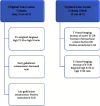The Epidemiology of COVID-19 Vaccine-Induced Myocarditis
- PMID: 38681683
- PMCID: PMC11045291
- DOI: 10.1155/2024/4470326
The Epidemiology of COVID-19 Vaccine-Induced Myocarditis
Abstract
Background: In December 2019, the emergence of severe acute respiratory syndrome coronavirus-2 (SARS-CoV-2) led to the COVID-19 pandemic, with millions of deaths worldwide. Vaccine breakthroughs in late 2020 resulted in the authorization of COVID-19 vaccines. While these vaccines have demonstrated efficacy, evidence from vaccine safety monitoring systems around the globe supported a causal association between COVID-19 vaccines, in particular those using mRNA technology, i.e., Moderna's mRNA-1273 and Pfizer-BioNTech's BNT162b2, and myocarditis.
Objective: This paper aims to investigate the epidemiology of mRNA COVID-19 vaccine-induced myocarditis, including age, ethnicity, and gender associations with these vaccines. It also discusses the immunopathophysiological mechanisms of mRNA COVID-19 vaccine-associated myocarditis and outlines principles of diagnosis, clinical presentation, and management.
Methods: A literature review was conducted using PubMed, Embase, and Queen Mary University of London Library Services databases. Search terms included "myocarditis," "coronavirus disease 2019," "SARS-CoV-2," "mRNA Covid-19 vaccines," "Covid vaccine-associated myocarditis," "epidemiology," "potential mechanisms," "myocarditis diagnosis," and "myocarditis management."
Results: While the definite mechanism of mRNA COVID-19 vaccine-associated myocarditis remains ambiguous, potential mechanisms include molecular mimicry of spike proteins and activation of the adaptive immune response with dysregulated cytokine expression. Male predominance in COVID-19 vaccine-induced myocarditis may be attributed to sex hormones, variations in inflammatory reactions, coagulation states based on gender, and female-specific protective factors. Moreover, an analysis of diagnostic and management strategies reveals a lack of consensus on acute patient presentation management.
Conclusion: In contrast to viral infections that stand as the predominant etiological factor for myocarditis with more severe consequences, the mRNA COVID-19 vaccination elicits a mild and self-limiting manifestation of the condition. There is currently insufficient evidence to confirm the definite underlying mechanism of COVID-19 vaccine-associated myocarditis. Further research is needed to develop preventive and therapeutic solutions in this context.
Copyright © 2024 Christos Costa and Foteini Moniati.
Conflict of interest statement
The authors declare that they have no conflicts of interest.
Figures







Similar articles
-
Postmarketing active surveillance of myocarditis and pericarditis following vaccination with COVID-19 mRNA vaccines in persons aged 12 to 39 years in Italy: A multi-database, self-controlled case series study.PLoS Med. 2022 Jul 28;19(7):e1004056. doi: 10.1371/journal.pmed.1004056. eCollection 2022 Jul. PLoS Med. 2022. PMID: 35900992 Free PMC article.
-
Myocarditis With COVID-19 mRNA Vaccines.Circulation. 2021 Aug 10;144(6):471-484. doi: 10.1161/CIRCULATIONAHA.121.056135. Epub 2021 Jul 20. Circulation. 2021. PMID: 34281357 Free PMC article. Review.
-
COVID-19 vaccination and myocarditis: A review of current literature.World J Virol. 2022 Jul 25;11(4):170-175. doi: 10.5501/wjv.v11.i4.170. World J Virol. 2022. PMID: 36159608 Free PMC article. Review.
-
Immunogenicity and safety of a booster dose of a self-amplifying RNA COVID-19 vaccine (ARCT-154) versus BNT162b2 mRNA COVID-19 vaccine: a double-blind, multicentre, randomised, controlled, phase 3, non-inferiority trial.Lancet Infect Dis. 2024 Apr;24(4):351-360. doi: 10.1016/S1473-3099(23)00650-3. Epub 2023 Dec 20. Lancet Infect Dis. 2024. PMID: 38141632 Clinical Trial.
-
COVID-19 vaccine-associated myocarditis.World J Cardiol. 2022 Jul 26;14(7):382-391. doi: 10.4330/wjc.v14.i7.382. World J Cardiol. 2022. PMID: 36161056 Free PMC article. Review.
Cited by
-
Advancing Myocarditis Research: Evaluating Animal Models for Enhanced Pathophysiological Insights.Curr Cardiol Rep. 2025 Jan 7;27(1):6. doi: 10.1007/s11886-024-02182-8. Curr Cardiol Rep. 2025. PMID: 39775161 Review.
-
Multisystem Endothelial Inflammation: A Key Driver of Adverse Events Following mRNA-Containing COVID-19 Vaccines.Vaccines (Basel). 2025 Aug 12;13(8):855. doi: 10.3390/vaccines13080855. Vaccines (Basel). 2025. PMID: 40872940 Free PMC article. Review.
-
The Ambivalence of Post COVID-19 Vaccination Responses in Humans.Biomolecules. 2024 Oct 17;14(10):1320. doi: 10.3390/biom14101320. Biomolecules. 2024. PMID: 39456253 Free PMC article. Review.
References
Publication types
LinkOut - more resources
Full Text Sources
Miscellaneous

